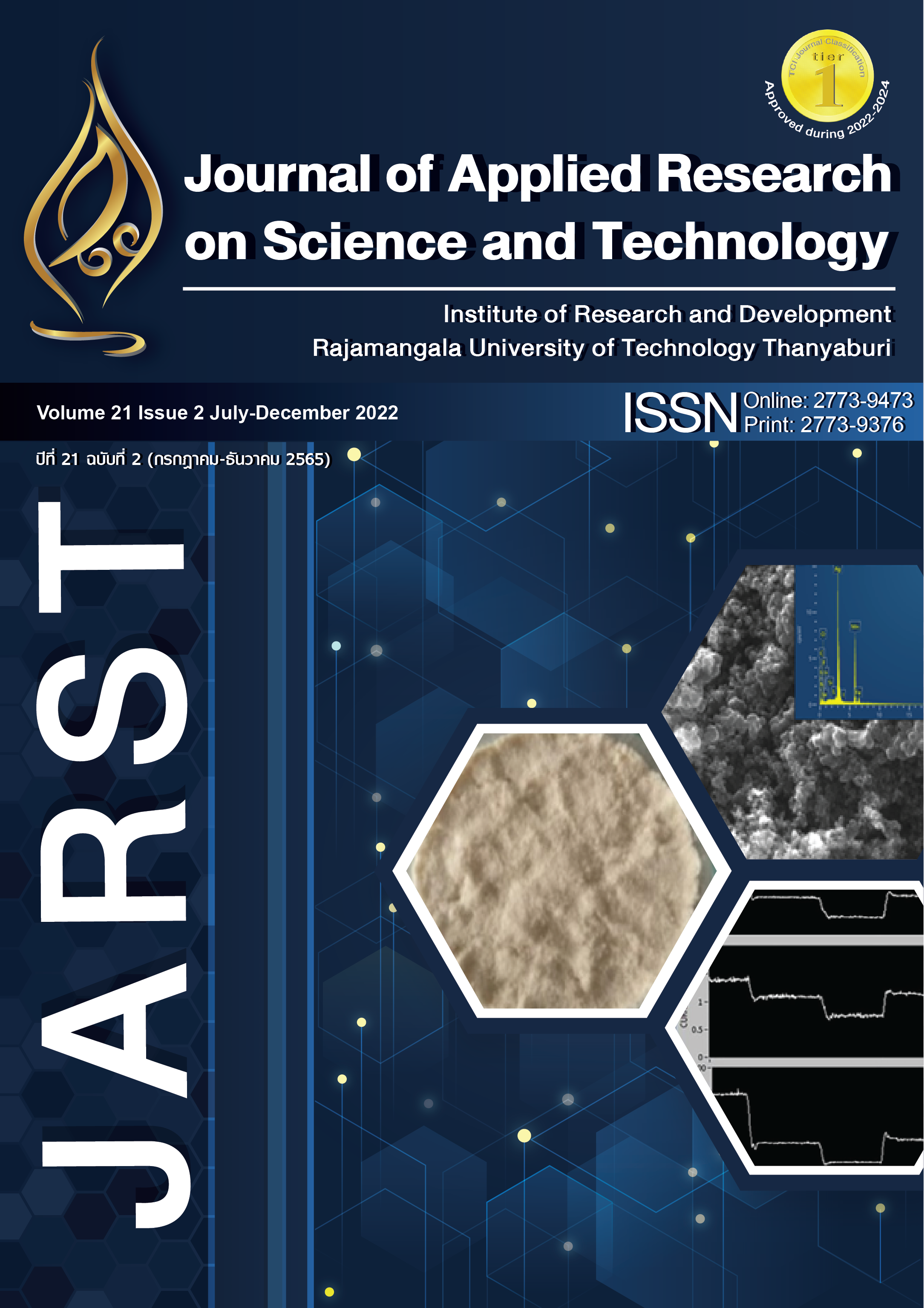A Novel Exopolysaccharides from Nitrogen Fixing Acetic Acid Bacterium, Nguyenibacter vanlangensis AR-R3
Main Article Content
Abstract
An acetic acid bacterium, Nguyenibacter vanlangensis AR-R3 was isolated from rice rhizosphere and exhibited nitrogen fixation as well as plant growth promotion properties. In addition, the bacterium can produce exopolysaccharides (EPS) to promote nitrogenase activity in the bacterial cells. These research objectives were aimed to purify and characterize EPS generated from an acetic acid bacterium, N. vanlangensis AR-R3. The pure culture was inoculated in Glucose-Yeast Extract-Peptone (GYP) medium broth (2% Glucose, 0.5% Yeast Extract, and 1% Peptone). The obtained culture supernatant was concentrated using a rotary evaporator, and then crude exopolysaccharides were precipitated with absolute ethanol. Crude polysaccharides were further purified via DEAE- Sephacel Column Chromatography and SephacrylTM S-400 Column Chromatography, respectively. According to the results of the study, exopolysaccharides purified from N. vanlangensis AR-R3 exhibited 4 average molecular weight sizes (Mw) of 2.180 x 108, 5.638 x 106, 5.523 x 105 and 1.990 x 105 Da, respectively. Sugar composition analysis of all 4 polysaccharides revealed the same composition of two types of monosaccharides, glucose and mannose. Regarding to purified exopolysaccharides from N. vanlangensis AR-R3 had molecular weights and monosaccharide compositions difference from other acetic acid bacteria reported so far. Thus, exopolysaccharide purified in this research would be a novel polysaccharide.
Article Details

This work is licensed under a Creative Commons Attribution-NonCommercial-NoDerivatives 4.0 International License.
References
Sievers M, Ludwig W, Teuber M. Phylogenetic positioning of Acetobacter, Gluconobacter, Rhodopila and Acidiphilum species as a branch of acidophilic bacteria in the α- subclass of Proteobacteria based on 16S ribosomal DNA sequences. System Appl Microbiol. 1994;17:189–96.
Trceck J, Barja F. Updates on quick identification of acetic acid bacteria with a focus on the 16S–23S rRNA gene internal transcribed spacer and the analysis of cell proteins by MALDI-TOF mass spectrometry. INT J Food Microbiol. 2015;96:137–44.
Pedraza RO. Recent advances in nitrogen-fixing acetic acid bacteria. INT J Food Microbiol. 2008;125:25-35.
Samaddar N, Paul A, Chakravorty S, Chakraborty W, Mukherjee J, Chowdhuri D, et al. Nitrogen fixation in Asaia sp. (family Acetobacteraceae). Curr Microbiol. 2011;63:226–31.
Janczarek M, Rachwal K, Ciesla J, Ginalska G, Bieganowski A. Production of exopolysaccharide by Rhizobium leguminosarum bv. trifolii and its role in bacterial attachment and surface properties. Plant Soil. 2015;388:211–27.
Deeraksa A, Moonmangmee S, Toyama H, Yamada M, Adachi O, Matsushita K. Characterization and spontaneous mutation of a novel gene, polE, involved in pellicle formation in Acetobacter tropicalis SKU1100. Microbiol. 2005;151:4111–20.
Samaddar N, Paul A, Chakravorty S, Chakraborty W, Mukherjee J, Chowdhuri D, et al. Nitrogen fixation in Asaia sp. (family Acetobacteraceae). Curr Microbiol. 2011;63:226-31.
Moonmangmee S, Kawabata K, Toyama H, Adachi O, Matsushita K. A novel extracellular polysaccharide from acetic acid bacterium, Asaia bogorensis NRIC 0311T. Biosci Bioeng. 2002;93:192-200.
Kato N, Mizuno M, Nakai Y, Nozaki K, Suga H, Kanda T, et al. Structure analysis of the water-soluble carbohydrate from Asaia bogorensis by NMR spectroscopy. J Appl Glycosci. 2007;54:231-33.
Janczarek M, Rachwal K, Ciesla J, Ginalska G, Bieganowski A. Production of exopolysaccharide by Rhizobium leguminosarum bv. trifolii and Its role in bacterial attachment and surface properties. Plant Soil. 2015;388:211-27.
Vu HTL, Yukphan P, Chaipitakchonlatarn W, Malimas T, Muramatsu Y, Bui UTT, et al. Nguyenibacter vanlangensis gen. nov., sp. nov., an unusual acetic acid bacterium in the α-Proteobacteria. J Gen Appl Microbiol. 2013;59:153-66.
Vu HTL, Bui UTT, Yukphan P, Malimas S, Kieu NP, Muramatsu Y, et al. The traits of the plant growth promoting acetic acid bacterium, Nguyenibacter vanlangensis. Vietnam J Sci Technol. 2019;57:439-48.
Meneses C, Gonçalves T, Alquéres S, Rouws L, Serrato R, Vidal M, et al. Gluconacetobacter diazotrophicus exopolysaccharide protects bacterial cells against oxidative stress in vitro and during rice plant colonization. Plant Soil. 2017;416:133-47.
Chawla PR, Bajaj IB, Survase, SA, Singhal RS. Microbial cellulose: fermentative production and applications. Food Technol Biotechnol. 2009;47:107–24.
Okiyama A, Motoki M, Yamanaka S. Bacterial cellulose II. Processing of the gelatinous cellulose for food materials. Food Hydrocolloids. 1992;6:479-87.
Czaja W, Krystynowicz A, Bielecki S, Brown RM. Microbial cellulose the natural power to heal wounds. Biomaterials. 2006;27:145-51.
Ubonrat J, Moonmangmee S, Khunajakr N, Moonmangmee D. Isolation and screening of plant growth promoting bacteria (PGPB) from rice (Oryza sativa) and rhizosphere soil. Sci Tech RMUTT J. 2018;8:190-204.
Dully JR, Grieve PA. A simple technique for eliminating interference by detergents in the lowry’s method of protein determination. Anal Biochem. 1975;64:136-41.
Dubois M, Gilles KA, Hamilton JK, Reber PA, Smith F. Colorimetric method for determination of sugar and related substances. Anal Chem. 1956;28:350-56.
Minakami H, Entani E, Tayama K, Fujiyama S, Masai H. Isolation and characterization of a new polysaccharide-producing Acetobacter sp. Agric Biol Chem. 1984;48:2405-14.
Moonmangmee S, Moonmangmee D, Adachi O, Toyama H. Novel exopolysaccharide from Kozakia baliensis. The 2nd International Conference on Acetic Acid Bacteria, November 11-14, Nagoya University, Nagoya, Japan. 2008. p. 100.
Mikkelsen D, Flanagan BM, Dykes GA, Gidley MJ. Influence of different carbon sources on bacterial cellulose production by Gluconacetobacter xylinus strain ATCC 53524. J Appl Microbiol 2009;107:576–83.
Serrato RV, Meneses CHSG, Vidal MS, Santana-Filho AP, Iacomini M, Sassaki GL, et al. Structural studies of an exopolysaccharide produced by Gluconacetobacter diazotrophicus Pal5. Carbohydr Polymer. 2013;98:1153–59.


